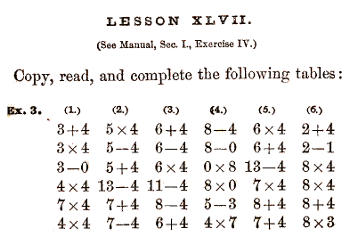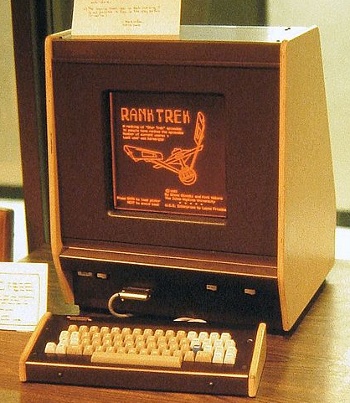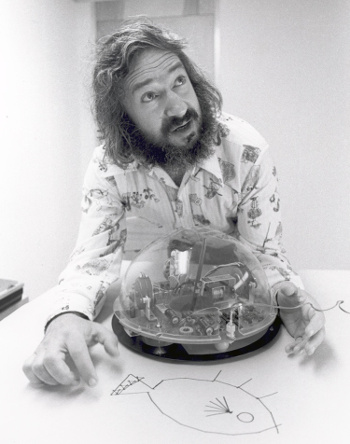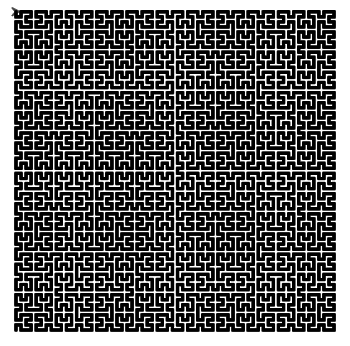Seymour Papert (1928-2016)
October 24, 2016
When my son was young, and
personal computers even younger, I wrote a
computer aided instruction (CAI)
program for him for the
elementary mathematics operations of
addition,
subtraction,
multiplication, and
division. At that time, we had an
Apple II clone, a
Franklin computer, for our
children to use, so I wrote the program in
BASIC. The program was an
electronic version of a
school workbook that would present practice problems and wait for answers to be entered.

A portion of page 51 of S. A. Felter and Erskine Hewitt, "The first lessons in numbers : an illustrated table book, designed for elementary instruction," Scribner, Armstrong, and Co. (New York, 1868), pp. 108, via archive.org)
Answers were checked, and there was a time limit on accepting an answer before the next problem was presented. In that way, I was able to include
logic to give more emphasis on the type of problem missed, reverting back to easier examples. As I remember, my son disliked using this program, but he was forced to used it nonetheless. Later, he became a
computer scientist. This program was
text-based, but in later years I wrote a
graphical CAI program in
Visual Basic that gave instruction on
Latin noun declension, this time for my
daughter.
These were not my first
forays into CAI. As a
graduate student, I was paid to write a CAI program on a simple
statistical concept for the
students of a
psychology professor. This program was hosted on an
IBM 360 mainframe computer, and it was written in the
APL programming language. I didn't get any user
feedback, but his students likely hated using this program as much as my son hated his math program.
Some programming topics have been with us from the origins of useful
computer hardware. There's
bookkeeping and
payroll,
language translation, and computer-aided instruction. The first general-purpose CAI system was
PLATO, an acronym for "Programmed Logic for Automated Teaching Operations." PLATO was conceived and programmed by
physicists, who routinely wander into areas not associated with
physics.[1]
In the late
1950s,
Chalmers W. Sherwin, a physicist at the
University of Illinois (Urbana, Illinois), proposed a CAI system to the
dean of
engineering, the engineering school being the
haven for a university computer and programming talent.
Donald Bitzer, an assistant to physics professor, Daniel Alpert, built a demonstration system. Bitzer, who realized that a
graphical user interface was important to a CAI system, is considered to be the
Father of PLATO.

(Via Wikimedia Commons))
As the project progressed, the
National Science Foundation provided funding for PLATO and a CAI
laboratory at the University of Illinois. Several years thereafter, PLATO was being implemented on a variety of mainframe computers worldwide, and it was eventually
licensed by
Control Data Corporation (CDC). Unfortunately, the expense of running such a system resulted in few customers, and PLATO was discontinued at CDC by the
mid-1980s.
In the decade after PLATO, a type of CAI specific to computer programming was developed at the
MIT spin-off,
Bolt, Beranek and Newman (BBN), by a
research team that included
Seymour Papert. Papert is known, also, for
co-authoring the book,
Perceptrons with
Marvin Minsky.[2] The BBN CAI instructor was
Logo, a
programming language that used a
pen-wielding "
turtle" as an output device. Seymour Papert died on July 31, 2016, at age 88.[3]

Seymour Papert (1928-2016).
Papert is shown with a Logo robot turtle.
Modern versions of Logo create turtle graphics on computer screens, not on paper. However, current student interest in robotics may bring back the mechanical turtle.
(Matematicamente.it photo, via Wikimedia Commons.)
The Logo language has simple commands for turtle movement, and it introduces the concept of
loops, as shown by this short example for drawing a
square 50 units on a side.
REPEAT 4 [FD 50 RT 90]
In this example, the command
FD 50 has the turtle move forward 50 units, the command
RT 90 calls for a 90-
degree right turn, and
REPEAT 4 has everything within the
brackets repeat four times to give the four sides of the square. As an exercise, a
computer science student could easily knock-out a Logo
interpreter in one of today's
high-level languages as a
class project. Some complex images can be made using Logo, as the following figure demonstrates.

One level of a Hilbert curve drawn using Logo.
German mathematician, David Hilbert, invented this fractal curve in 1891. If the curve continued, it would completely fill the plane.
(Via twentygototen.org.)[4])
Seymour Papert was born on
February 29, 1928, in
Pretoria, South Africa. Papert, whose
father was an
entomologist, was awarded a
Ph.D. in
mathematics from the
University of the Witwatersrand (Johannesburg, South Africa) in 1952.[4] He received a second Ph.D. in mathematics, this time from
Cambridge University (Cambridge, UK), in 1959.[4]
In a surprising shift for someone with two mathematics Ph.D.s, Papert went to the
University of Geneva to work with the
Swiss psychologist,
Jean Piaget, from 1959-1963. It was there that he developed his
theory of
education that children learn from doing more than from
studying.[4]
Papert came to the
Massachusetts Institute of Technology (MIT, Cambridge, Massachusetts) in 1963 to work on
artificial intelligence with Marvin Minsky. In 1967, he was named a
professor of
applied mathematics, and he served as
co-director with Minsky of the
MIT Artificial Intelligence Laboratory.
Papert was one of the founding faculty of the
MIT Media Laboratory in 1985, and he participated in its
One Laptop per Child (OLPC) project to
manufacture inexpensive
laptop computers to be used worldwide. While it's
estimated that more than 3 million such laptops were shipped, the advent of inexpensive
cellphones and
tablet computers has offered an inexpensive alternative. Papert was also involved in the creation of
Lego Mindstorms.
Papert's
philosophy of education is summarized in
Papert's principle, that
"Some of the most crucial steps in mental growth are based not simply on acquiring new skills, but on acquiring new administrative ways to use what one already knows."[5]
References:
- In the 1970s, there was a joke that a physicist is the type of programmer who writes a database application in Fortran. That's because Fortran is the staple language of physics. There were better database languages, even in those dim days.
- Marvin Minsky and Seymour A. Papert, "Perceptrons: An Introduction to Computational Geometry, Expanded Edition," The MIT Press, December 28, 1987, Paperback, 308 pp., ISBN-13: 978-0262631112.
- Gary S. Stager, "Seymour Papert (1928–2016)," Nature, vol. 537, no. 7620 (September 15, 2016), doi:10.1038/537308a.
- Examples: koch snowflake, hilbert curve, spiral, twentygototen.org. "20 GOTO 10" specifies an infinite loop in several languages.
- Marvin Minsky,"Chapter 10: Papert's Principle," from The Society of Mind, Simon & (New York, 1988), p. 102 (via Amazon).
Permanent Link to this article
Linked Keywords: Personal computer; educational technology; computer aided instruction; computer program; elementary mathematics operation; addition; subtraction; multiplication; division; Apple II; clone; Franklin computer; child; children; BASIC; electronic; school workbook; archive.org; logic; computer science; computer scientist; text-based computing; graphics; graphical; Visual Basic; Latin; noun declension; daughter; foray; postgraduate education; graduate student; statistics; statistical; student; psychology; professor; IBM System/360; mainframe computer; APL programming language; corrective feedback; computer hardware; bookkeeping; payroll; language translation; PLATO computer system; acronym; physicist; physics; 1950s; Chalmers W. Sherwin; University of Illinois (Urbana, Illinois); dean; engineering; haven; Donald Bitzer; graphical user interface; A picture is worth a thousand words; computer terminal; plasma display; Wikimedia Commons; National Science Foundation; laboratory; intellectual property license; Control Data Corporation; mid-1980s; Massachusetts Institute of Technology; MIT; spin-off; Bolt, Beranek and Newman; research; author; Perceptrons; Marvin Minsky; Logo programming language; pen; turtle; Seymour Papert (1928-2016); robot; graphics; computer monitor; computer screen; paper; robotics; loop; square; degree; bracket; interpreter; high-level language; class project; Hilbert curve; mathematician; David Hilbert; fractal curve; space-filling curve; twentygototen.org; February 29; Pretoria, South Africa; father; entomology; entomologist; Doctor of Philosophy; Ph.D.; University of the Witwatersrand (Johannesburg, South Africa); Cambridge University (Cambridge, UK); University of Geneva; Switzerland; Swiss; psychologist; Jean Piaget; theory; education; study skill; study; artificial intelligence; professor; applied mathematics; co-director; MIT Artificial Intelligence Laboratory; MIT Media Laboratory; One Laptop per Child; manufacturing; manufacture; laptop computer; approximation; estimate; mobile phone; cellphone; tablet computer; Lego Mindstorms; philosophy; Papert's principle.